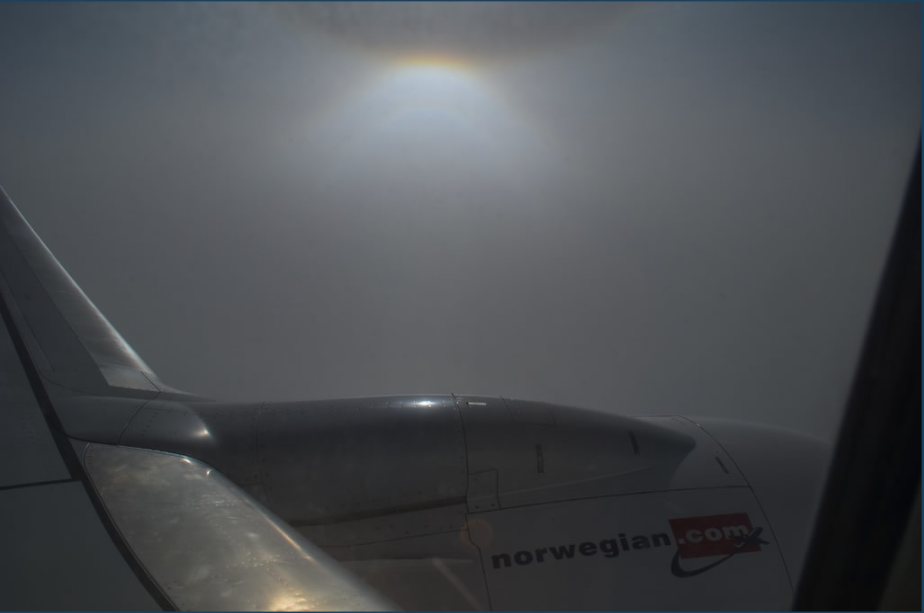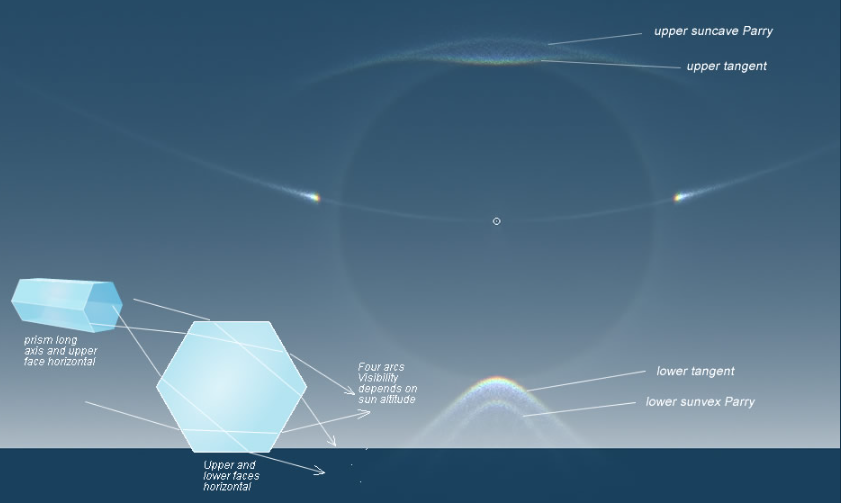Lower Parry arc over Finland - OPOD
Lower Parry Arc over Finland - A Rare Atmospheric Optics Phenomenon
Ice halos are captivating atmospheric phenomena that occur when sunlight interacts with ice crystals suspended in the atmosphere. Recently, a lucky observer, Heli Kesti, had the opportunity to witness and capture a rarely seen ice halo display known as the Lower Parry Arc. This remarkable event took place between Oulu and Helsinki, Finland. Let's delve into the details of this intriguing optical phenomenon.
The Lower Parry Arc is a faint arc that appears inside the lower tangent arc, which itself is formed when the sun's rays pass through cirrus clouds containing ice crystals. The Lower Parry Arc is an even rarer occurrence, and its appearance is a true gem for any atmospheric optics enthusiast. In fact, its name pays homage to the renowned British Arctic explorer, William Edward Parry, who would have undoubtedly been thrilled to witness this phenomenon.
The Lower Parry Arc is typically observed when the sun is relatively low in the sky, resulting in a lower sunvex Parry arc. In Heli Kesti's photographs, the arc appears at approximately 30° above the horizon. The presence of this arc is confirmed by analyzing the shape of the lower tangent arc, the separation of the Parry arc, and the distance of sundogs from the 22° halo. These elements provide valuable clues for understanding the atmospheric conditions that give rise to this captivating phenomenon.
To gain further insight into the formation of the Lower Parry Arc, researchers have employed ray tracing simulations using specialized software such as HaloSim. These simulations help identify the specific path of light rays that generate the observed arc. By applying ray filters and considering various factors such as sun elevation, scientists can narrow down the potential ray paths that give rise to this optical phenomenon.
Parry columns, which play a crucial role in generating halos, have a distinct orientation with their long axes and prism faces positioned horizontally. This unique orientation, combined with their high efficiency in producing halos, contributes to the formation of the Lower Parry Arc. These ice crystals interact with sunlight in a way that creates arcs near the 22° halo, resulting in the mesmerizing display observed by Heli Kesti.
It is important to note that witnessing the Lower Parry Arc is a rare occurrence due to the specific atmospheric conditions required for its formation. The presence of cirrus clouds containing ice crystals, a relatively low sun elevation, and the precise alignment of Parry columns all contribute to the appearance of this optical phenomenon. The combination of these factors must align perfectly for observers to have the privilege of witnessing this captivating display.
In conclusion, the Lower Parry Arc is a remarkable atmospheric optics phenomenon that occurs when sunlight interacts with ice crystals in the atmosphere. Its appearance inside the lower tangent arc adds an extra layer of rarity to an already fascinating display. Thanks to the fortunate positioning and keen observation skills of Heli Kesti, we have been granted a glimpse into this captivating event. The study of such phenomena not only enhances our understanding of atmospheric optics but also provides a source of wonder and appreciation for the natural world around us.

A rarely seen Parry arc
Heli Kesti saw this ice halo display between Oulu and Helsinki, Finland.
"Fortunately, by chance we got a place just in front of the wing and a man gave me a place by the window."
Fortunate indeed. The ~30° high sun shone through cirrus crystals to give a bright lower tangent arc (or maybe a circumscribed halo for the latter forms at 29°).
But the gem is the fainter arc inside the lower tangent - A rarely visible lower sunvex Parry arc. Parry would have liked the chance to see this!
All images ©Heli Kesti

The Parry arc came and went. At right a colour subtraction enhancement of the centre image.

A HaloSim ray tracing for a 30° high sun. The approximate sun elevation is obtained from the shape of the lower tangent arc, the separation of the Parry arc and the distance of the sundogs from the 22° halo.
Parry columns have their long axes horizontal AND a prism face horizontal. A rare orientation offset by the high efficiency with which they generate halos.
Four ray paths give arcs near the 22° halo. Whether they are possible or not depends on the sun elevation. They are shown versus sun elevation here and here.
Run HaloSim with its ray filters active to identify the ray that generated Heli's arc.
Note: this article has been automatically converted from the old site and may not appear as intended. You can find the original article here.
Reference Atmospheric Optics
If you use any of the definitions, information, or data presented on Atmospheric Optics, please copy the link or reference below to properly credit us as the reference source. Thank you!
-
<a href="https://atoptics.co.uk/blog/lower-parry-arc-over-finland-opod/">Lower Parry arc over Finland - OPOD</a>
-
"Lower Parry arc over Finland - OPOD". Atmospheric Optics. Accessed on November 21, 2024. https://atoptics.co.uk/blog/lower-parry-arc-over-finland-opod/.
-
"Lower Parry arc over Finland - OPOD". Atmospheric Optics, https://atoptics.co.uk/blog/lower-parry-arc-over-finland-opod/. Accessed 21 November, 2024
-
Lower Parry arc over Finland - OPOD. Atmospheric Optics. Retrieved from https://atoptics.co.uk/blog/lower-parry-arc-over-finland-opod/.